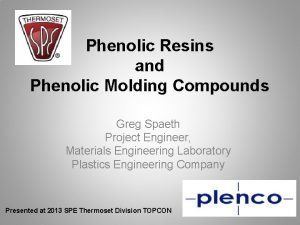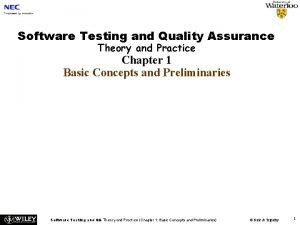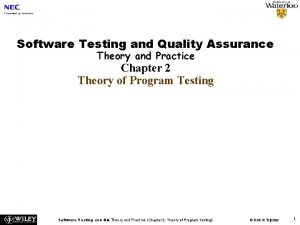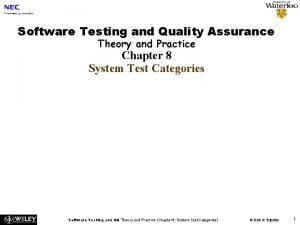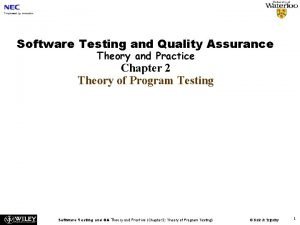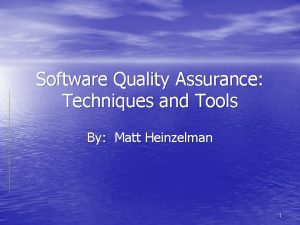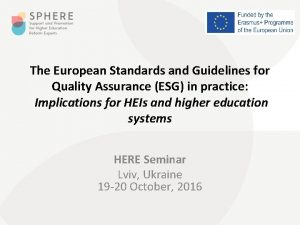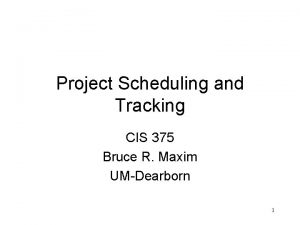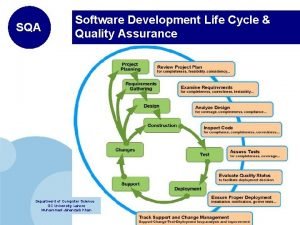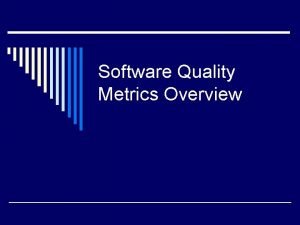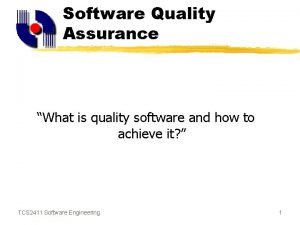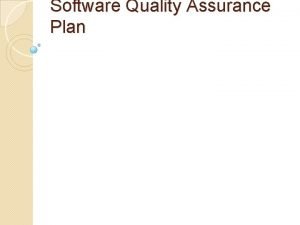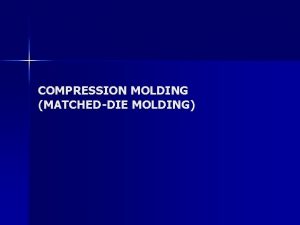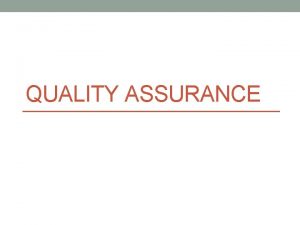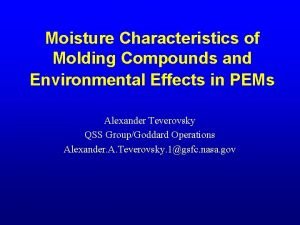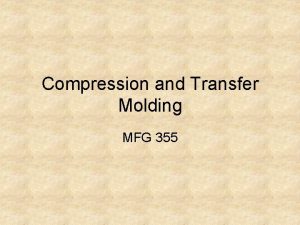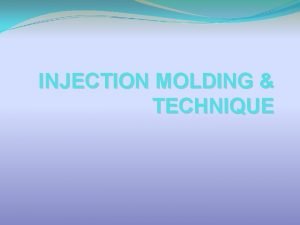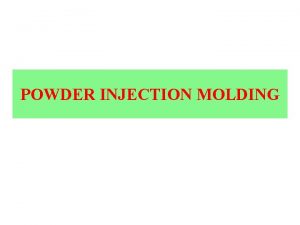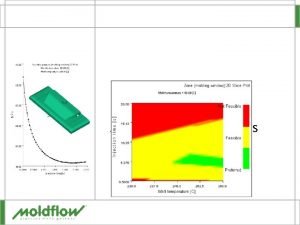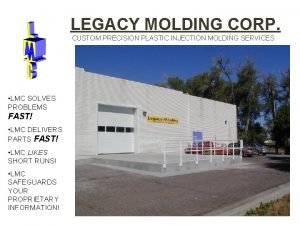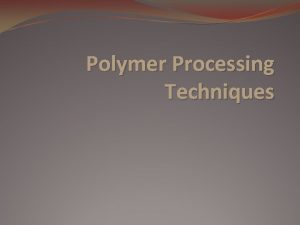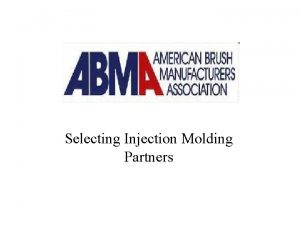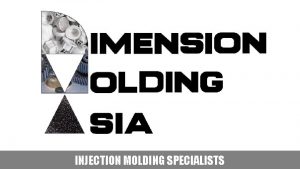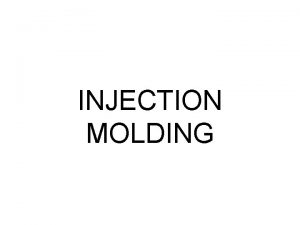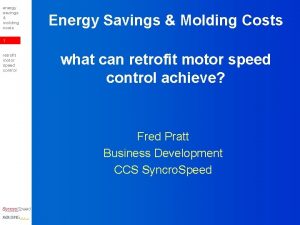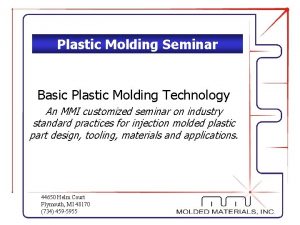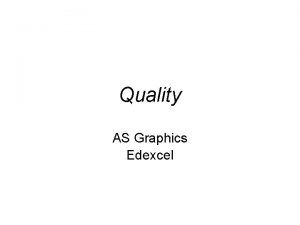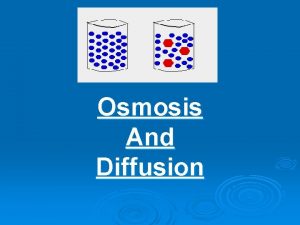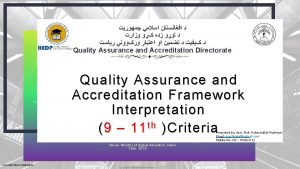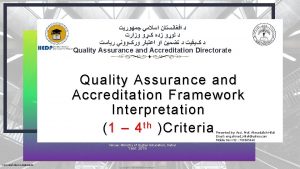Moisture Diffusion in Molding Compounds and Quality Assurance













![What is the HAST acceleration? Best-fit model: S. Peck [86]; Hallberg and Peck [91]; What is the HAST acceleration? Best-fit model: S. Peck [86]; Hallberg and Peck [91];](https://slidetodoc.com/presentation_image/2139297dd54f6947d3682f2081a349b8/image-14.jpg)








- Slides: 22

Moisture Diffusion in Molding Compounds and Quality Assurance of PEMs for Space Applications Alexander Teverovsky QSS Group, Inc. /Goddard Operations Alexander. A. Teverovsky. 1@gsfc. nasa. gov

No humidity in space. Why moisture concerns? We need to assure that no moisture related failures occur during the ground phase integration and testing period (2 to 5 years). Quality assurance strategy for PEMs: § Moisture prevention § Adequate qualification testing MRQW Dec '02 2

Quality assurance strategy for PEMs for military and space applications Moisture prevention strategy: Military applications: Wafer Applied Seal for PEM Protection (WASPP); Space applications: Virtual monitoring/simulation of the moisture level variations and baking of components and assemblies. Adequate testing: Military applications: To assure reliability for 15 to 20 years of storage and operation in harsh humid environments. Space applications: To assure reliability for 5 years maximum in controlled laboratory conditions. MRQW Dec '02 3

Purpose and Outline The purpose is to discuss: Moisture characteristics of MCs and how they can be used for the moisture prevention strategy and for development of adequate testing. The relevance of HAST for PEMs intended for space applications. Outline: Part I: • • Bake-out conditions for PEMs; Diffusion characteristics of molding compounds. Part II: • • Acceleration factors of HAST. What might be an adequate testing? MRQW Dec '02 4

Part I. Moisture Diffusion Characteristics and Their Measurement The first step in any MC or PEM degradation process is moisture diffusion. The characteristic times of diffusion are important for implementing the moisture prevention strategy. MRQW Dec '02 5

Characteristic times of moisture diffusion in plastic encapsulated parts The master curve for moisture diffusion Bake-out time: t(T) = h 2/D(T) t 2 h – package thickness At t => C/Co=0. 1, M/Mo=0. 06 Moisture concentration at the die surface and mass losses of a flat package with rated baking time. MRQW Dec '02 6

Diffusion characteristics of epoxy encapsulating materials Data reported in literature. D 85 varies ~ 10 times Averaged characteristics of MC: Do = 7. 35 10 -6 m 2/sec U = 0. 43 e. V MRQW Dec '02 7

Calculated bake times at 125 o. C and JEDEC recommendations • Ignoring real size of the parts causes significant errors. • JEDEC is focused on SMT reflow soldering and might be not adequate for moisture control purposes. Three body thickness groups per IPC/JEDEC J-STD-033 A, July 2002: <1. 4 mm; <2 mm; < 4. 5 mm IPC-SM-786 A, ’ 95: < >2 mm MRQW Dec '02 Note: • 2 a and 5 a are levels of moisture sensitivity. • part saturated at 30 o. C/85% RH 8

In-situ non-isothermal technique for D(T) A. Teverovsky, “A Rapid Technique for measurements Moisture Diffusion Characterization of Molding Compounds in PEMs“, http: //nepp. nasa. gov Areas of application § Moisture sorption simulation (virtual monitoring of moisture level). § Calculation of bake-out conditions. § Lot characterization of molding compound. (ROBOCOTS: need rapid assessment methods) § Evaluation of moisture leaks along the leads of a plastic package. § Development of adequate moisture stress testing (HAST alternative). MRQW Dec '02 9

Part II. Highly Accelerated Stress Test (HAST) Do we need to use same environmental stress testing as for PEMs intended for harsh humid conditions? MRQW Dec '02 10

Accelerated moisture resistance tests § JESD 22 -A 102 -C (unbiased autoclave): 121 o. C, 100% RH, 24 to 336 hrs (96 hr typical). § JESD 22 -A 118 (unbiased HAST): Cond. A: 130 o. C, 85% RH, 96 hrs. Cond. B: 110 o. C, 85% RH, 264 hrs. § JESD 22 -A 110 -B (biased HAST): Cond. A: 130 o. C, 85% RH, 96 hrs. Cond. B: 110 o. C, 85% RH, 264 hrs. Equivalent to 1000 hours at 85 o. C and 85% RH Typical HAST conditions: bias at 130 o. C, 85% RH § 96 hrs per JESD 22 -A 110 -B. § 150 hrs per NAVSEA SD 18 (Part Requirement & Application Guide). § 500 hrs per PRF 38535 spec. (for technology characterization). NASA projects: 250 hrs? MRQW Dec '02 11

HAST failure mechanisms Package level § Corrosion of the leads. § Dendrite formation (on the surface and inside packages). § Swelling/shrinkage: ü Delaminations; ü Solder ball failures in PBGA and flip-chip technology; ü warpage of large packages; ü parametric shifts in linear devices. MRQW Dec '02 12

HAST failure mechanisms Die level: § Corrosion of Al metallization. § Dendrites between metallization lines. § Leakage currents. § Charge instability (lateral, ion drift, hot electron). HEXFET failures MRQW Dec '02 Curtsy of C. Greenwell Mechanisms of moisture induced parametric degradation require additional analysis 13
![What is the HAST acceleration Bestfit model S Peck 86 Hallberg and Peck 91 What is the HAST acceleration? Best-fit model: S. Peck [86]; Hallberg and Peck [91];](https://slidetodoc.com/presentation_image/2139297dd54f6947d3682f2081a349b8/image-14.jpg)
What is the HAST acceleration? Best-fit model: S. Peck [86]; Hallberg and Peck [91]; S. Tam [95]; SSB-1 [2000]; J. Sweet [02]: 0. 7 < Ea < 1. 1 e. V; 1<n<5 Ea = 0. 8 e. V; n = 2. 7 Life time increases with device temperature MRQW Dec '02 14

Test results on linear devices 11 part types out of 25 failed HAST: 130 o. C, 85% RH, 250 hours Part DC Pack. type Vref 0112 SOIC 8 31 3 1 - increased Vout 2 - catastrophic Opamp Instr. amp 0101 SOIC 16 30 2 - 0033 SOIC 8 30 30 Excessive input currents FET 1 0041 SOT 223 29 28 IDS, VGTH FET 2 0040 D 2 Pak 30 29 ~ 60% parametric shift MRQW Dec '02 QTY tested failed Failure mode 15

Is HAST adequate for normal conditions? Testing temperature (130 o. C) is above the operational range for many parts. Degradation of molding compound: § Decrease of Tg (up to 100 o. C in resins and up to 30 o. C in MCs). § Enhanced creep. § Decrease of the tensile stress and adhesion. The model accelerates mostly corrosion failures, but corrosion is no longer a prime concern. Moisture assisted hot-carrier degradation might have U < 0. MRQW Dec '02 16

Irreversible changes in MCs: An example Test: moisture uptake and swelling after HAST were measured on two epoxy molding compounds. Conditions: saturation with moisture at 85% RH and different temperatures. Additional mechanical stresses due to swelling: A E [( MC LF) T + m], At MC LF mechanical stresses are due only to moisture sorption. An increase in volume might cause delaminations and mechanical failures. MRQW Dec '02 17

Do we need moisture testing? Ionic dissociation in polymer: Charge carriers are impurity ions generated by dissociation of a salt MA The equilibrium constant: no is the concentration of salt molecules; f is the fractional degree of dissociation In a medium with low : Uo is the energy of ions separation in vacuum 1. Moisture concentration at the die surface at RT is approximately the same as at high T/RH conditions. 2. Another reason: Moisture activates ionic impurities similar to temperature. Moisture testing might accelerate degradation mechanisms related to charge instability. MRQW Dec '02 18

A possible alternative to HAST: MS + HTB Moisture evolution in a 2 mm thick package Testing at 85 o. C. Soaking in humidity chamber for 48 hrs at 110 o. C and 85% RH Note: C/Co = 1 corresponds to the equilibrium moisture saturation at 100% RH. MRQW Dec '02 19

Calculated test time and equivalent time of operation Soaking conditions: RH = 95%, T = 110 o. C, t = 30 hr Test conditions: RHeff 90% 70 o. C < T < 105 o. C Operating conditions (environment): Package thickness 2 mm MRQW Dec '02 RH =50% T = 20 o. C 20

HAST alternative: MS + HTB testing Algorithm for calculation of MS+HTB testing conditions Input: Package size; D(T) data; ground phase conditions; maximum storage and operation temperatures. Set RH and T for MS conditions Estimate HTB time C(t) simulation Calculate A and t Estimate MS time Set T for HTB conditions C(t) simulation MRQW Dec '02 - Is A & t suitable? + MS + HTB Test conditions 21

Conclusion Suggested quality assurance strategy: moisture content control (virtual monitoring and baking) + adequate testing. The moisture prevention strategy can be implemented by assessment of moisture content and calculations of the bake-out conditions based on D(T) data. The existing HAST conditions are too harsh for PEMs intended for space applications. A possible alternative to HAST might be MS + HTB testing. Additional analysis of moisture induced parametric degradation and acceleration factors is necessary. MRQW Dec '02 22
 Quality assurance vs quality control
Quality assurance vs quality control Basic concepts of quality assurance
Basic concepts of quality assurance Pmp quality vs grade
Pmp quality vs grade What are quality standards in project management
What are quality standards in project management Define quality assurance in nursing
Define quality assurance in nursing Quality improvement vs quality assurance
Quality improvement vs quality assurance Phenolic molding compounds
Phenolic molding compounds Diffusion vs facilitated diffusion
Diffusion vs facilitated diffusion Stimulus diffusion diagram
Stimulus diffusion diagram Software testing and quality assurance: theory and practice
Software testing and quality assurance: theory and practice Software testing and quality assurance theory and practice
Software testing and quality assurance theory and practice Theory of goodenough and gerhart
Theory of goodenough and gerhart Software testing and quality assurance theory and practice
Software testing and quality assurance theory and practice Quality assurance theory
Quality assurance theory Ionic covalent and metallic bonds venn diagram
Ionic covalent and metallic bonds venn diagram Sqa tools and techniques
Sqa tools and techniques European standards and guidelines for quality assurance
European standards and guidelines for quality assurance Project scheduling and tracking software quality assurance
Project scheduling and tracking software quality assurance Sqa life cycle
Sqa life cycle In process quality metrics
In process quality metrics Software quality assurance iso standards
Software quality assurance iso standards Software assurance plan
Software assurance plan Abo antisera
Abo antisera






